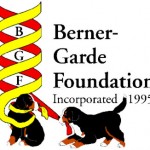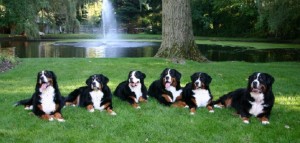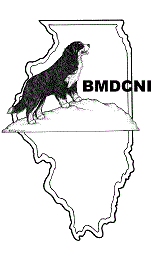The Berner Garde Foundation Berner Lingo
THE BERNER-GARDE FOUNDATION WAS ESTABLISHED TO COLLECT, MAINTAIN AND DISSEMINATE INFORMATION ABOUT GENETIC DISEASES OBSERVED IN THE BERNESE MOUNTAIN DOG. THE BERNER-GARDE FOUNDATION IS A 501(c)(3) TAX-EXEMPT, NOT-FOR-PROFIT CORPORATION.

BERNER HEALTH and BERNER-LINGO 101
By Julie Latterell and Brycie Marine
BMD Repository Co-Liaison’s
Berner-Garde Trustees
There is a common misperception that information on health is only important for dogs that will be used in breeding. However, we offer the following up as a hypothetical example of why that is NOT true. Everyone that loves Bernese Mountain Dogs (BMD’S) should be concerned about doing what we can to help ensure a healthier future for our breed!
Jane is a BMD breeder. She has decided she is going to breed her girl Penny for the very first time. She picks out a male, Hugo, that she thinks will improve upon the areas where Jane is not as strong. She diligently researches the pedigrees and health histories of both dogs and decides Hugo is the best fit for her girl Penny.
Penny whelps a beautiful litter of 10 puppies. Jane decides to keep the best male, Boris from the litter for future breeding, and places the rest of the puppies in companion homes. Boris matures into a beautiful dog. At 2-years of age, he has passed all health clearances (hips, elbows, cardiac, DM, von Willdebrand’s, CERF eye exam). Boris finished his AKC Championship at 16 months of age and turned out so well that Jane decides to do a repeat breeding with Penny and Hugo.
The above sounds like a perfect scenario right? Penny and Hugo produced a lovely puppy that passed all health clearances and he is a wonderful example of the breed. Of COURSE Jane would want to repeat the breeding!
Would you feel differently if you had this additional information?
Of the 9 puppies placed in companion homes from the Penny/Hugo breeding, 3 had elbow dysplasia and 2 had severe hip dysplasia. One puppy limped as a youngster, but the owners didn’t do hip or elbow x-rays. One puppy died at an early age from some type of cancer (owners didn’t do a necropsy, so not sure of the type) and another died at 1-years of age from kidney failure.
With this additional information, Jane might give more serious thought about repeating this breeding. She might in fact decide that she wasn’t happy with the orthopedics and other health issues produced in this litter that she decides to look for a different sire for her next breeding of Penny.
Without the information provided by the companion dog owners about the health and orthopedics of the 9 puppies that went to pet homes, Jane would be operating with incomplete information on which to make future breeding decisions. Since everyone wants a happy, healthy, long-lived Berner, the information we have to share as companion dog owners is vitally important to help breeders make the best breeding decisions possible.
Of course this story is fictitious. Jane isn’t a real person, and the breeding of Penny and Hugo didn’t happen. However, the scenario above can and does happen! Well-researched breeding’s sometimes don’t have the desired results health-wise. Without the information from puppies sold as companions, breeders are operating with limited information. So even though your dog may never be used for breeding, you still have a wealth of information to share!
The following is an explanation of some commonly used Berner-lingo that truly committed owners and breeders should understand. If you understand the Berner-lingo, and actively participate, you and your dog can help shape a healthier future for our breed!

BERNER LINGO:
Berner-Garde – www.bernergarde.org
An on-line health database specifically for Bernese Mountain Dogs that may be accessed and used by ANYONE! Breeders use it to research pedigrees and health histories of dogs that are potential breeding prospects, owners or potential owners use it to research breeders and families of dogs to make informed puppy-buying decisions and health researchers have access to it to study families of dogs and genetic diseases. It includes health information, pedigrees, titles earned and photos for nearly 87,000 BMD’s. Information is voluntarily submitted by owners, breeders, and stud-dog owners, as well as entered from other sources such as show catalogs, OFA, AKC and owner-submitted veterinary health records.
BMD Repository
The BMD Repository safely stores blood, cheek-swab DNA and tumor tissue samples from BMD’s. The Repository is collaboration between Berner-Garde and Michigan State University that was established in 2007. These samples provide a wealth of information to health researchers who are studying genetic diseases that affect canines and specifically BMD’s. Samples are voluntarily submitted through local and regional BMD Repository clinics, and from generous individual dog owners. The BMD Repository currently has nearly 2000 cheek-swab DNA samples, well-over 1600 blood samples and 155 tumor samples. It is a way for owners and breeders to actively participate in helping shape a better and healthier future for our breed. We are always looking for more samples for the Repository, as more samples = more information. You can get a Frozen Tissue Sample Kit by contacting anyone on our LIST.
Health Liaison
Individuals from each regional club that are aware of the current health research studies in our breed and are aware of the BMD Repository sample submission process locally and may help organize regional Repository clinics for their clubs. They are also advocates for Berner-Garde and can help you understand how to submit information on your dogs if you haven’t used the database before.

